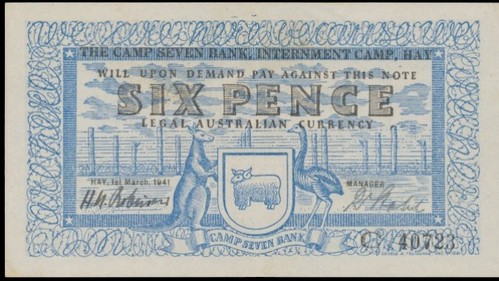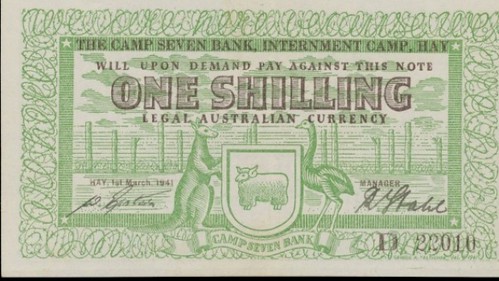
PREV ARTICLE
NEXT ARTICLE
FULL ISSUE
PREV FULL ISSUE
AUSTRALIA WWII REFUGEE CAMP SCRIP NOTES OFFERED
Some rare WWII Australian refugee camp notes are coming up for sale. Here's an article from a New Zealand publication. -Editor

Refugees, and what to do with them, were also a major concern during the Second World War. One solution was to place them on a ship and send them to the other side of the world, Australia for example. Which explains why a shipload of German and Austrian refugees arrived in Sydney on board the Dunera. The British suspected them of being spies or Nazi sympathisers, which was unlikely as most were Jewish. From Sydney, the Dunera Boys, as they were later called, were taken by train to Camp Seven, near Hay. Some were wealthy businessmen. Their money was confiscated and while interned, the only available currency was a series of banknotes and some generic tokens. The Hay banknotes were special. They were designed by the internees then printed by a local newspaper. They were so sophisticated that the Australian Treasury feared that they would be traded outside the camp. After three months of circulation in 1941, the notes were confiscated and destroyed, although some examples were kept as souvenirs by internees. 
This then is a classic case of the rarity factor. A catalogue prepared by M. H. R. Bullus (now out of print), records that only 2000 of the two shilling notes were printed, with about 3000 for other denominations. A survey published in 1994 recorded only 174 surviving notes. According to the laws of supply and demand, the value of the surviving notes has increased dramatically over the past decade. So the news that a complete set of the banknotes, covering all denominations and combinations of signatures, is to be offered as part of Australian auction house Mossgreen's first coins and banknotes sale has sparked great interest. To their knowledge this is the first complete set of set to be offered at a public auction. The sale will be held on Thursday evening in Melbourne. The estimates for the banknotes are conservative, according to specialist Nick Anning, given that most of the collection are in the highest EF (extremely fine) or UNC (uncirculated) categories. Top value of $15,000 is for a two shilling, red and black note in uncirculated condition. A green one shilling note, also uncirculated, is given estimates of A$12,500 ($13,640). Blue sixpence banknotes are valued at $8000, or $10,000 for a consecutively numbered pair.
Is any scrip in use at today's refugee camps in Europe? The time to document and collect this stuff is NOW, before these ephemeral
issues disappear. -Editor
To read the complete article, see:
Wayne Homren, Editor The Numismatic Bibliomania Society is a non-profit organization promoting numismatic literature. See our web site at coinbooks.org. To submit items for publication in The E-Sylum, write to the Editor at this address: whomren@gmail.com To subscribe go to: https://my.binhost.com/lists/listinfo/esylum All Rights Reserved. NBS Home Page Contact the NBS webmaster 
|